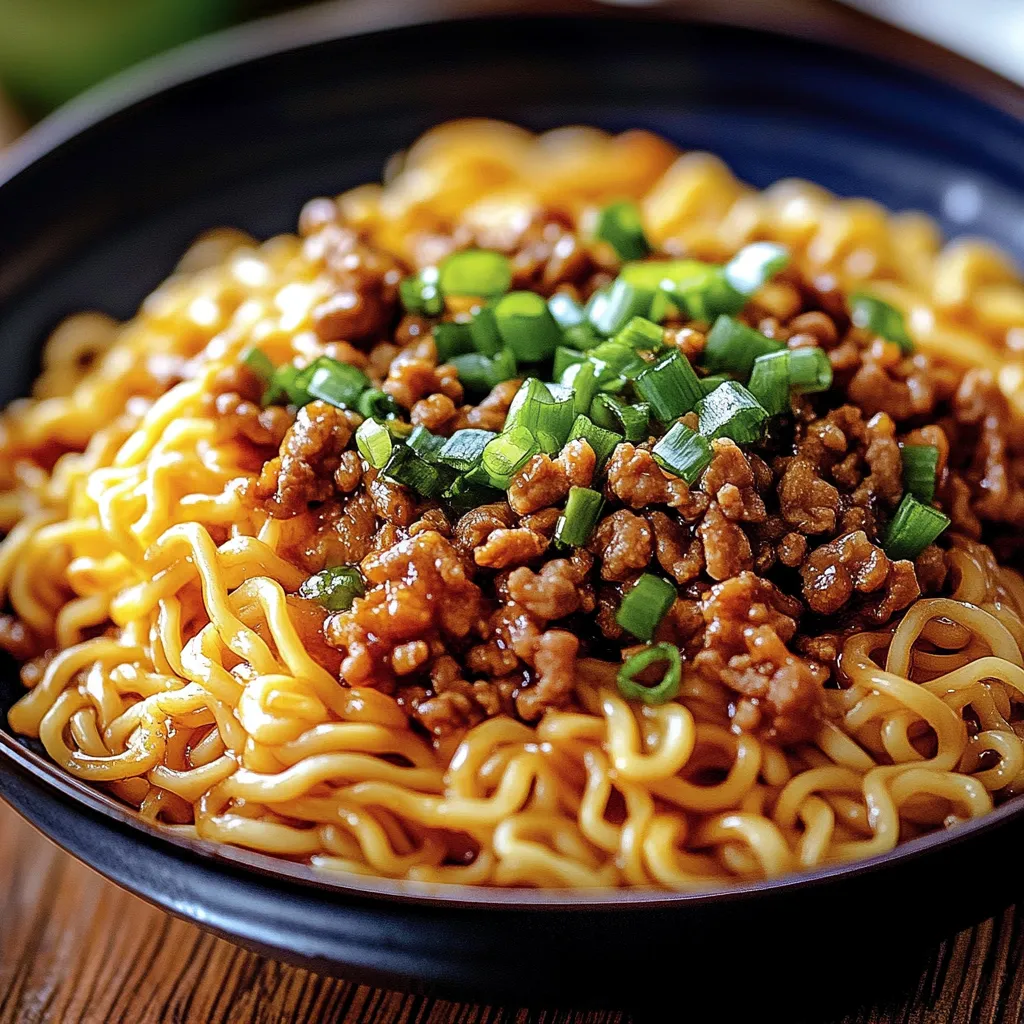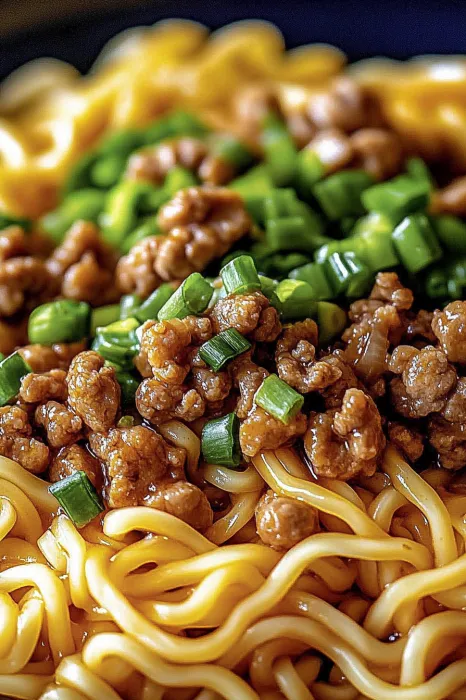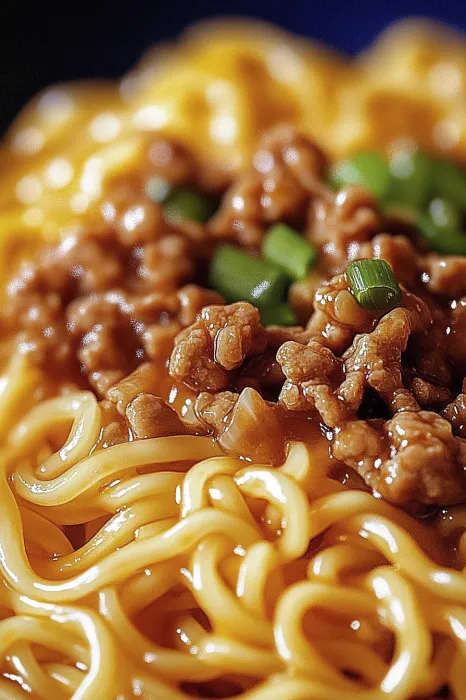 Pin it
Pin it
This hearty Sichuan noodle dish brings authentic Chinese flavors right to your kitchen with its perfect balance of heat, umami, and texture. The combination of chili oil, Sichuan peppercorns, and savory meat creates an unforgettable meal experience that will transport you straight to the streets of Chengdu.
I first made this dish after returning from a trip to China's Sichuan province, desperately trying to recreate the incredible street food I had enjoyed. After several attempts, this version became my go to comfort food that even my spice sensitive friends request regularly.
Ingredients
- Fresh or dried Chinese wheat noodles: Provide the perfect chewy texture that absorbs the flavorful sauce. Regular spaghetti works in a pinch.
- Bok choy: Adds a fresh crunch and nutritional balance to the rich flavors. Choose ones with firm stalks and vibrant green leaves.
- Chili oil: Delivers the signature heat. Look for varieties with visible chili flakes for best texture and flavor.
- Sesame paste: Creates the creamy base for the sauce. Tahini is an excellent substitute if you cannot find Chinese sesame paste.
- Sichuan peppercorns: Provide that distinctive numbing sensation. Try to find whole peppercorns and grind them yourself for maximum aromatic qualities.
- Ground pork: Adds rich savory flavor. Choose a cut with at least 15% fat content for the best texture and taste.
- Chinese black vinegar: Brings essential tanginess. Aged varieties have more complex flavor profiles worth seeking out.
Step-by-Step Instructions
- Prepare the Noodles:
- Bring a large pot of water to a rolling boil over high heat. Add the noodles and cook according to package instructions until they reach al dente texture, typically 4 to 6 minutes for fresh noodles or 8 to 10 minutes for dried. Test by tasting a strand. The noodles should be cooked through but still offer some resistance when bitten. Immediately drain and rinse under cold water to stop the cooking process and prevent sticking.
- Create the Sauce Base:
- In a medium bowl, add the sesame paste or tahini first. Gradually whisk in the hot water, stirring continuously until the mixture becomes smooth and creamy with no lumps. This step is crucial as adding all liquid at once will cause the paste to seize. Now incorporate the chili oil, soy sauce, black vinegar, sugar, and ground Sichuan peppercorns if using. Taste and adjust seasonings, noting that the flavors will intensify once mixed with hot noodles.
- Prepare the Meat Topping:
- Heat a wok or large skillet over high heat until slightly smoking. Add the vegetable oil and swirl to coat the surface. Add the ground pork or chicken, breaking it up with a wooden spoon into small pieces. Allow it to cook undisturbed for 1 minute to develop browning, then stir and continue cooking until no pink remains, about 4 to 5 minutes. Add the minced garlic and ginger, stirring constantly for 30 seconds until fragrant but not burned. Pour in the soy sauce and hoisin, tossing to coat all the meat evenly. The mixture should be glossy and well seasoned.
- Blanch the Vegetables:
- Bring a small pot of water to boil. Add the bok choy or spinach and cook for just 30 seconds until bright green and slightly wilted. Immediately transfer to an ice water bath to preserve the vibrant color and stop the cooking. Once cooled, gently squeeze out excess water and roughly chop the larger pieces for easier eating.
- Assemble the Dish:
- Divide the prepared sauce among serving bowls, spreading it evenly across the bottom. Add the cooked noodles on top and toss thoroughly to ensure every strand is coated with the flavorful sauce. Arrange the blanched vegetables and meat topping over the noodles. Finish with a generous sprinkle of chopped green onions and crushed peanuts or sesame seeds if using. Serve immediately while still hot.
 Pin it
Pin it
My absolute favorite ingredient in this dish is the Sichuan peppercorns. The first time I experienced their unique numbing sensation paired with chili heat, it completely transformed my understanding of what spicy food could be. My Chinese friend's grandmother taught me that properly toasting and grinding them releases their full citrusy aroma that makes this dish truly special.
Balancing The Heat
The beauty of Sichuan cuisine lies in its complex heat profile. Unlike other spicy cuisines that simply burn, Sichuan dishes create a fascinating interplay between the numbing sensation from Sichuan peppercorns and the heat from chili oil. For beginners, start with just 1 tablespoon of chili oil and a pinch of Sichuan peppercorns, then gradually increase with subsequent preparations as your palate adjusts. Remember that the numbing effect actually makes the dish more enjoyable by tempering the chili heat. For an authentic experience, aim for a balance where your lips tingle pleasantly but you can still taste all the other flavors in the dish.
Make Ahead Tips
This Sichuan noodle dish comes together quickly but requires several components that can be prepared in advance for even faster assembly. The sauce base can be mixed and refrigerated for up to 3 days. The meat topping can be cooked and stored for up to 2 days, though it tastes best when freshly made. Vegetables can be blanched a day ahead and kept crisp in the refrigerator. Even the noodles can be cooked, tossed with a small amount of oil to prevent sticking, and refrigerated overnight. When ready to serve, simply reheat the meat topping, warm the noodles briefly in hot water, and assemble as directed for a restaurant quality meal in minutes.
Regional Variations
This recipe represents just one interpretation of Sichuan noodle dishes, most closely resembling Dan Dan noodles. In different parts of Sichuan province, you will find countless variations. Some versions use a clear, brothier sauce rather than the thick sesame based sauce here. Others incorporate preserved vegetables called yacai, which add unique fermented flavor. In Chongqing, a similar dish is made significantly spicier with additional chili oil and is topped with braised beef instead of ground pork. The beauty of Sichuan cuisine lies in its adaptability. Once you master this version, experiment with regional variations to discover your own favorite interpretation of this beloved dish.
 Pin it
Pin it
Frequently Asked Questions
- → Can I adjust the spiciness of this dish?
Yes, you can adjust the spiciness by adding or reducing the amount of chili oil to suit your taste preferences.
- → What can I use as a meat substitute for a vegetarian version?
You can substitute the ground meat with crumbled tofu or finely chopped mushrooms for a vegetarian option.
- → Can I use an alternative to Sichuan peppercorns?
Sichuan peppercorns provide a unique numbing heat, but you can omit them if unavailable, or substitute with a pinch of ground black pepper.
- → What type of noodles should I use?
Fresh or dried Chinese wheat noodles are ideal, but spaghetti can also work as a substitute in a pinch.
- → Can I prepare this dish ahead of time?
The sauce and meat mixture can be prepared in advance, but it's best to cook and assemble the noodles just before serving to maintain their texture.
